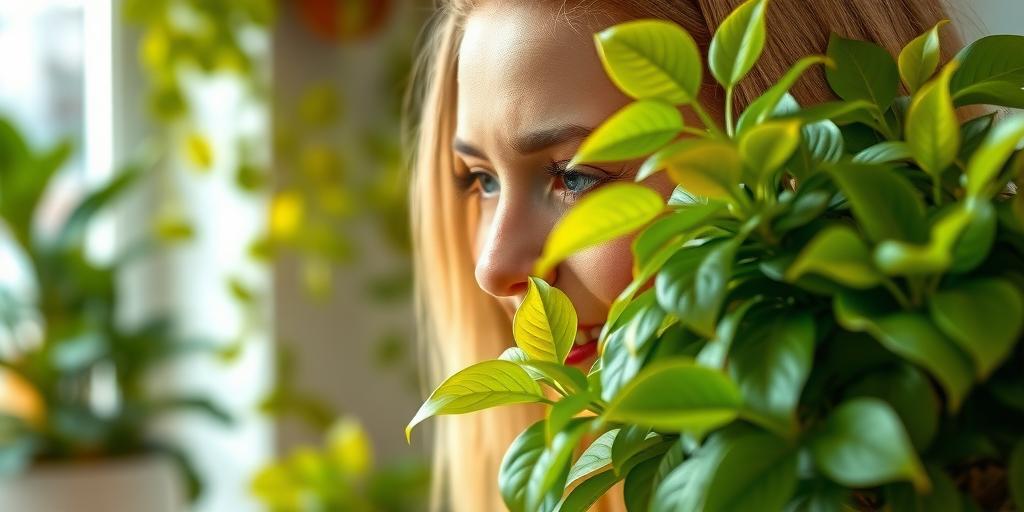
How to Fix Yellow Leaves on Low Light Hanging Plants: Solutions and Tips
Discover expert solutions to fix yellow leaves on low light hanging plants! Learn the causes, prevention tips, and easy fixes to revive your indoor greenery.
Introduction
Are your low light hanging plants turning yellow? Don’t panic—you’re not alone! Many indoor gardeners face this issue, but the good news is that it’s often fixable. Yellow leaves can signal anything from overwatering to nutrient deficiencies, and understanding the root cause is the first step to saving your plant. In this guide, we’ll explore the most common reasons for yellowing leaves and provide actionable tips to restore your plant’s health. Let’s bring those lush green leaves back to life!
Common Causes of Yellow Leaves in Low Light Hanging Plants
Overwatering: How Soggy Soil Leads to Root Rot and Yellowing
One of the most common mistakes plant owners make is overwatering, especially with low light hanging plants. These plants typically grow slower in dim conditions, meaning they take longer to absorb moisture. When the soil stays soggy for too long, the roots suffocate and begin to rot. As root rot sets in, the plant can no longer take up nutrients properly, leading to yellowing leaves.
To avoid this, always check the soil before watering. If the top inch feels damp, hold off. Over time, you’ll learn your plant’s specific needs—some prefer drying out slightly between waterings, while others like consistently moist (but not wet) soil.
Insufficient Light: Why Low Light Plants Still Need Some Brightness
Just because a plant is labeled “low light” doesn’t mean it can survive in complete darkness. These plants still need some indirect light to photosynthesize. Without enough light, chlorophyll production slows, causing leaves to turn pale or yellow.
If your hanging plant is in a dim corner, try moving it closer to a north-facing window or a spot with filtered light. Even a few hours of gentle morning sun can make a big difference.
Nutrient Deficiency: Key Signs Your Plant Lacks Nitrogen or Iron
Yellow leaves can also signal a nutrient deficiency. Nitrogen is essential for healthy green growth, and when levels drop, older leaves often turn yellow first. Iron deficiency, on the other hand, causes yellowing between the veins of new leaves.
If you suspect a nutrient issue, consider using a balanced, water-soluble fertilizer. Just be careful not to overdo it—too much fertilizer can burn roots and worsen the problem.
Poor Drainage: How Compacted Soil Harms Root Health
Even if you’re watering correctly, poor drainage can still cause problems. Compacted or heavy soil prevents excess water from escaping, trapping moisture around the roots. Over time, this creates the same issues as overwatering.
To fix this, repot your plant in a well-draining mix. Adding perlite, orchid bark, or coarse sand can help improve aeration. Also, make sure your hanging pot has drainage holes to let excess water escape.
Pests & Diseases: Common Culprits Like Spider Mites and Fungal Infections
Yellow leaves can sometimes be a sign of pests or diseases. Spider mites, mealybugs, and scale insects suck sap from leaves, causing discoloration and weakness. Fungal infections, often due to excess moisture, can also lead to yellow or spotted foliage.
Inspect your plant regularly, especially the undersides of leaves where pests like to hide. If you spot any invaders, treat them early with insecticidal soap or neem oil. For fungal issues, reduce humidity and improve air circulation.
How to Diagnose the Problem
Check Soil Moisture: The Finger Test and Moisture Meters
Before assuming the worst, start by checking the soil. Stick your finger about an inch deep—if it feels wet, overwatering may be the issue. If it’s bone dry, your plant might be thirsty. For a more precise reading, a moisture meter can help eliminate guesswork.
Inspect Leaves & Stems: Spotting Discoloration, Spots, or Pests
Look closely at the yellowing leaves. Are they uniformly yellow, or do they have spots or streaks? Spots could indicate pests or disease, while uniform yellowing often points to watering or nutrient problems. Also, check the stems for any signs of rot or pests.
Review Light Conditions: Measuring Indirect vs. Direct Light Needs
Assess where your plant is hanging. Is it in complete shade, or does it get a few hours of indirect light? Low light plants still need some brightness, so if the area is too dark, consider moving the plant or supplementing with a grow light.
Assess Fertilization Schedule: Are You Over or Underfeeding?
Think about when you last fertilized. If it’s been months, your plant might need a nutrient boost. On the flip side, if you’ve been fertilizing frequently, you could be overdoing it. Flush the soil with water to remove excess salts if you suspect fertilizer burn.
Step-by-Step Solutions to Fix Yellow Leaves
Adjust Watering Habits: Finding the Right Balance for Your Plant
If overwatering is the issue, let the soil dry out before watering again. For underwatered plants, give them a thorough soak until water runs out of the drainage holes. Going forward, adjust your schedule based on the plant’s needs and the season—plants usually need less water in winter.
Improve Light Exposure: Best Placement for Low Light Plants
Move your plant to a brighter spot, but avoid direct sunlight, which can scorch leaves. A few feet away from an east or north-facing window is ideal. If natural light is limited, a grow light can provide the necessary brightness without overheating the plant.
Repot with Proper Soil: Choosing Well-Draining Mixes
If your plant is suffering from poor drainage, repot it in fresh, airy soil. A mix designed for aroids (like pothos or philodendrons) or adding perlite to standard potting mix can help. Make sure the new pot has drainage holes to prevent future issues.
Fertilize Correctly: Organic vs. Synthetic Options
Use a balanced fertilizer (like a 10-10-10 formula) every 4-6 weeks during the growing season. Organic options, such as compost tea or worm castings, are gentler and less likely to cause burns. Always follow the instructions to avoid overfeeding.
Treat Pests & Diseases: Natural Remedies and Safe Pesticides
For pests, wipe leaves with a damp cloth or spray with neem oil. For fungal issues, remove affected leaves and improve airflow. If the problem persists, consider a fungicide, but always test a small area first to avoid harming the plant.
Preventative Care for Healthy Hanging Plants
Create a Watering Schedule: Tailored to Your Plant’s Needs
Instead of watering on a fixed day, adjust based on soil moisture and seasonal changes. Keep a simple journal or set reminders to check the soil weekly until you get into a rhythm.
Rotate Plants Regularly: Ensuring Even Light Distribution
To prevent one-sided growth, rotate your hanging plant every few weeks. This ensures all sides receive equal light, keeping the foliage balanced and healthy.
Prune Yellow Leaves: When and How to Trim Safely
Remove yellow or dead leaves to redirect energy to healthy growth. Use clean scissors and cut close to the stem without damaging it. Avoid removing more than 20% of the foliage at once to prevent shock.
Use Humidity Trays: Boosting Moisture for Tropical Plants
Many low light hanging plants, like philodendrons, thrive in higher humidity. Place a tray of water and pebbles beneath the pot to increase moisture levels without making the soil soggy.
Monitor Growth Patterns: Early Signs of Stress to Watch For
Pay attention to new growth—if it’s pale or stunted, your plant might need more light or nutrients. Slow growth in the growing season could also indicate root-bound conditions, signaling it’s time to repot.
Best Low Light Hanging Plants Resistant to Yellowing
Pothos: Hardy and Adaptable
Pothos is nearly foolproof, tolerating low light and occasional neglect. Its trailing vines add a lush touch, and it bounces back quickly if you correct watering mistakes.
Spider Plant: Thrives in Indirect Light
Spider plants are resilient and produce plenty of offshoots, making them great for beginners. They prefer bright, indirect light but can handle lower light conditions.
Philodendron: Low-Maintenance and Forgiving
With heart-shaped leaves and a forgiving nature, philodendrons are perfect for low light spaces. They’re also excellent at signaling their needs—drooping when thirsty.
Peperomia: Compact and Colorful
Peperomias come in many varieties, some with striking red or silver leaves. They’re slow-growing and prefer drying out slightly between waterings.
ZZ Plant: Nearly Indestructible
The ZZ plant thrives in low light and can go weeks without water. Its waxy leaves retain moisture, making it one of the toughest houseplants around.
By understanding the causes of yellow leaves and taking proactive steps, you can keep your low light hanging plants healthy and vibrant. Each plant has its own preferences, so observe and adjust care routines as needed.
Conclusion
Yellow leaves on your low light hanging plants don’t have to be a death sentence! By diagnosing the issue early and applying the right fixes—whether it’s adjusting water, light, or nutrients—you can revive your plant and keep it thriving. Remember, prevention is key: consistent care and the right environment will help avoid future problems. Ready to give your plants the TLC they deserve? Start today and enjoy greener, healthier foliage in no time!
